This three day Hue itinerary has been designed expressly for casual cyclists. It can easily be used as a guide for anybody with an interest in history visiting Hue. Apart from the sights specifically mentioned here, you'll also pass wonderful old pagodas, less visited royal tombs and beautiful rural scenes.
Briefing
Many travellers only allocate a day or so to Hue and plenty find the place a disappointment. Like most good things though, some extra research effort and extra time here, will reward - especially those with a strong interest in Vietnam’s incredible history. More than two centuries of major events unfolded here including some of the most important events of the Vietnam War.
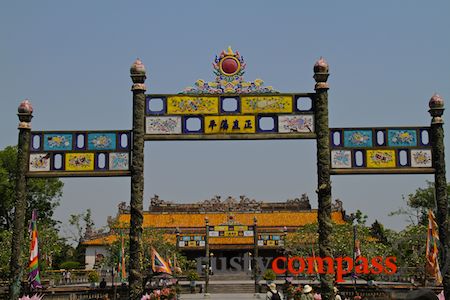
Photo: Mark BowyerHue Citadel
Travel tips
- The season in which you travel will impact on how you choose to do your cycling. You’ll want to avoid strenuous cycling in the scorching midday heat of summer. Early mornings and late afternoons are perfect. The damp and cooler winter will be less draining but may also be less picturesque.
- Quality bicycles aren’t easy to come by in Hue unless you’re staying in the La Residence. Fortunately the rides are easy so a substandard bike is no excuse for not cycling.
-This cycling itinerary can easily be done by car or by xe om - motorcycle taxi. Even if you’re cycling, you may find it convenient to have a xe om driver join you to help navigate. Most places are pretty easy to find and the locals are always ready to help though that can sometimes complicate matters.
The itinerary
Day 1 - Morning Thien Mu Pagoda, Hue Citadel and Army Museum
3 - 4 hours. Easy cycling
Start time - as early as possible - preferably around 7AM or earlier.
Cross Trang Tien bridge and head west along Le Duan St past the citadel to Thien Mu Pagoda about 6 kms away. Best to arrive here before the crowds. Thien Mu is one of Vietnam’s most beautiful and atmospheric pagodas - and there’s plenty of history here as well. It was from here that Monk Thich Quang Duc travelled to Saigon in June 1963. His self-immolation on a busy Saigon St shocked the world and forced the US Government to acknowledge the brutality of the Presidency of Ngo Dinh Diem. Diem was executed in a coup five months later.
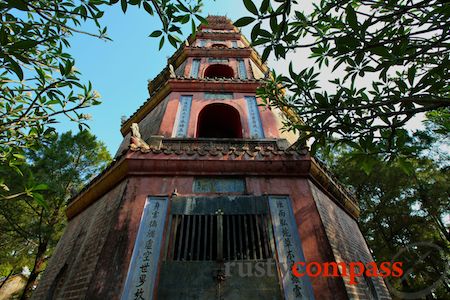
Photo: Mark BowyerThien Mu Pagoda, Hue
From there, take the short ride on to the citadel where you will likely spend 90 minutes to 2 hours walking around the expansive ruins. Take some time to venture out to the distant edges of the complex. You’ll likely have the place to yourself and see original buildings in terminal decline.
Jump on your bike and ride along the Citadel wall to the Army Museum. The museum may do little justice to Hue’s battle drenched history - especially in the Vietnam War - but it’s worth a quick visit.
Another five minute ride will place you at Lac Thien Restaurant (6 Dinh Tien Hoang St,) - a good local lunch option serving tasty Hue and other Vietnamese dishes near the main Citadel entrance.
Day 1 Afternoon - Old streets, Fine Arts Museum and An Dinh Palace, Tu Cung residence, Hue Cathedral, back streets around the citadel, Bach Dang St, Chi Lang area, Dong Ba Market, Ho Chi Minh's former residence.
3 - 4 hours. Easy cycling
Head away from the river to Phan Dinh Phung St stopping first at An Dinh Palace where the simple but interesting Royal Fine Arts Museum is located, Then take a look at the palace itself, commissioned by Emperor Khai Dinh. It was a residence of the last Emperor Bao Dai and was recently restored as part of German Government aid project.
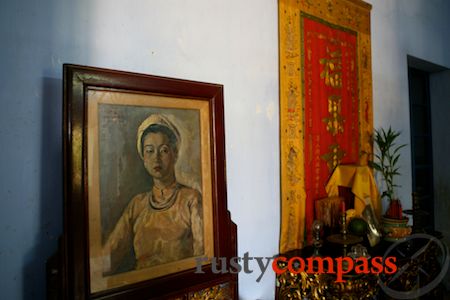
Photo: Mark BowyerThe melancholy residence where Khai Dinh's Queen saw out her final days, Hue.
From here, travel past Hue’s slightly odd Catholic Cathedral to the Trang Tien Bridge and back towards the Citadel. Head east along the southern side of the citadel moat before reaching the inner wall. This will take you along to the small alleys and lanes of old Hue. Tran Huy Lieu is a good alley to take north. You can potter around here and mix with friendly locals and then get directions to nearby Bach Dang St. You may like to ride around the entire citadel wall as well this afternoon.
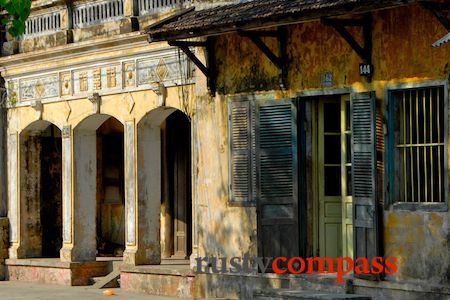
Photo: Mark BowyerBach Dang St, Hue
Just outside the eastern citadel along the Dong Ba canal is Bach Dang St - one of Hue’s classic streets. You should hit it nearby Dieu De Pagoda - one of the National Pagodas of imperial times and a stronghold of Buddhist militancy against Ngo Dinh Diem and his family in the 1960s.
Take a relaxed look at the old shophouses and pagodas of Bach Dang St before heading up to Chi Lang St. This was where Hue’s once substantial Chinese community lived. If you feel like tasting some of Hue’s local dishes, head off Chi Lang St to 7 Nguyen Binh Khiem St where Ba Do and her team will take care of you. This is very much a no frills stop but a favourite with the locals. It’s a good place to end the afternoon with a pre dinner snack.
On your way back to town along Chi Lang, you might want to stop off at Dong Ba market - Hue’s central market.
Day 2 - Full day cycling - Minh Mang’s Tomb, Khai Dinh’s Tomb, Tu Hieu, Tu Duc’s Tomb, Ho Quyen, National School, Ho Chi Minh Museum
Full day - moderate fitness required with more than 50kms of cycling broken up though the day.
The tombs of the Nguyen Dynasty emperors are scattered through the picturesque countryside close by Hue making them easily accessible by bike. The rides are part of the fun taking you through small villages, farms and past lesser known imperial ruins that can be well worth a stop.
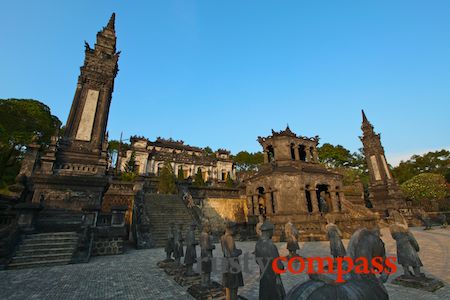
Photo: Mark BowyerKhai Dinh's Tomb, Hue
Head along Dien Bien Phu St and follow the signs to Minh Mang’s Tomb. This is the furthest part of the ride (60 - 90 mins depending on stops) so it makes sense to head their first. You’ll probably want an hour to explore the tomb.
From Minh Mang’s Tomb, head back towards town and follow the signs to Khai Dinh’s Tomb. Khai Dinh’s is the most recent of the royal tombs and is completely different to Minh Mang’s and Tu Duc’s more traditional creations. Khai Dinh included plenty of European touches. The small collection of imperial artefacts adds to the value of a visit here.
Time for lunch. Make your way back towards Hue, there are a number of both local style and tourist friendly restaurants not far from Khai Dinh’s tomb.
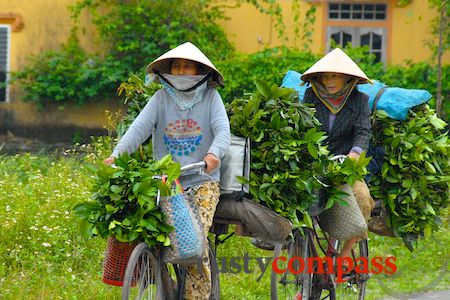
Photo: Mark BowyerCycling Hue's country lanes
Then it’s on to nearby Tu Hieu Pagoda - famous for its eunuch graves and for Thich Nhat Hanh, one of Buddhism’s most celebrated monks. This is a lovely atmospheric spot. Monks can be heard chanting at 10AM and 4PM.
From Tu Hieu cruise back towards Hue first taking a detour to visit Ho Quyen, the Emperor's former stadium. Make sure you continue a little further along to the beautifully decrepit Long Chau Dien temple overlooking a picturesque lotus pond. Then it's back to Hue stopping at any of the sites along Le Loi St - Ho Chi Minh Museum and the National School with its neglected World War I memorial opposite.
Day 3 - Gia Long’s Tomb OR Thanh Toan Bridge and Thuan An beach.
A solid morning of cycling
After two pretty solid days of exploration, you’ll have a good sense of Hue and its geography. If the energy levels are still running high, there are two options for this morning - an early morning cycle out to Gia Long’s tomb - more than 18kms from town or, a less rigourous country ride to Thanh Toan Bridge.
Gia Long’s Tomb
Gia Long was the first Nguyen Dynasty emperor. His tomb is vast but run down. The setting is idyllic though and the ride along the river to get there is beautiful. The journey ends with a short boat trip across to the tomb.
Unless you find something very local, you’ll probably have to wait until you’re getting close to Hue for something to eat.
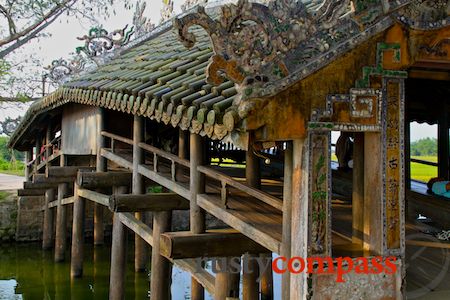
Photo: Mark BowyerThanh Toan Bridge outside Hue
Alternatively, Thanh Toan Bridge is an 18th century covered bridge set in pretty countryside 8kms from Hue. The ride itself through the rice paddies and lanes is a big part of the attraction. And if you want to continue your cycling, you could head to the coast and Thuan An beach for a seafood lunch and dip.
Spend your last afternoon walking, cycling and relaxing around the Perfume River with no set plan. You may also want to take a boat trip along the river.








There are no comments yet.